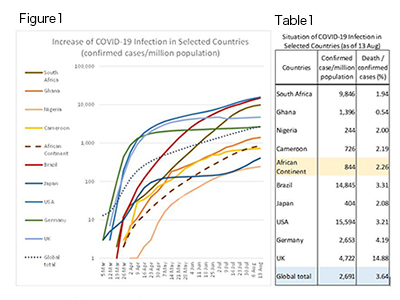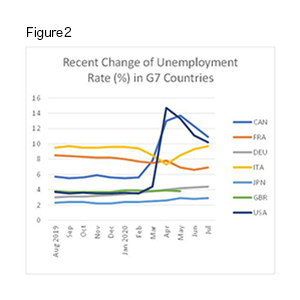Blog 'Can Society Turn Adversity Into Opportunity?—Searching for Answers in the Kaizen Movement Under the Coronavirus Pandemic in Africa'
2020.11.04
At the JICA Ogata Sadako Research Institute for Peace and Development, researchers and staff with various experiences and backgrounds are forging partnerships with diverse stakeholders and partners. We will share their knowledge and perspectives gained from their research activities in the form of blog posts. Jin Kimiaki of JICA Ogata Research Institute wrote about productivity improvement activities called kaizen, which can be applied in our response to COVID-19.
Jin Kimiaki
JICA Ogata Sadako Research Institute for Peace and Development
While COVID-19 has been spreading worldwide, a figure in Weekly Epidemiological Update published by the World Health Organization (WHO) in September 2020, shows that the pandemic may have peaked in Africa in July. Notably, in Ghana and Kenya, the number of new infections per week has decreased in September, and in South Africa, despite being the country with the highest number of infections on the continent, the Coronavirus Disease 2019 (COVID-19) alert level has been downgraded. Under these circumstances, implementing policies that rebuild economic activity while containing the infection is necessary. This essay explores such policies in relation to the kaizen movement, an initiative aimed at increasing productivity.
On March 11, 2020, I was in Durban, South Africa. I decided to cancel our workshop for assessing the impact of kaizen on the auto industry only 5 days before the event. At that time, the number of reported COVID-19 cases was approximately 128,000 worldwide, including 4,292 deaths. In South Africa, seven cases had been reported. However, South African joint researchers and partner companies had already predicted that the pandemic could become a health crisis. By September 20, 2020, COVID-19 had infected approximately 30,680,000 individuals, of whom approximately 950,000 had died. At that time, the number of cases and deaths in South Africa were approximately 660,000 and 16,000, respectively. South Africa was experiencing the fastest rate of infection in Africa and the eighth largest number of cases worldwide. Figure 1 and Table 1 present the number of COVID-19 cases per one million population and the percentage of deaths for the selected countries, including four African nations, i.e., Cameroon, Ghana, Nigeria, and South Africa. Data are cited from Coronavirus Disease (COVID-2019) Situation Reports and Weekly Epidemiological Updates published by the WHO (2020-a). Notably, based on the average number of infections for the entire continent, the failure of Africa to control the infection can be observed.

Source: Compiled by the author from WHO, COVID-2019 Situation Reports
Lockdowns have been implemented as an effective measure to prevent the spread of COVID-19. However, to what extent residents’ behaviors should be restricted in the context of the virus’s impact on their livelihoods is a difficult decision. In South Africa, at the time I wrote this essay, the COVID-19 alert level was at 1 out of 5 and could change, depending on the situation. By May 2020, 42 African countries had implemented total or partial lockdowns (UNECA 2020). An estimation is that as a result, the total hours worked in Africa decreased 1.7% and 9.5%, respectively, in the first and second quarters of 2020 from the fourth quarter of 2019 (ILO 2020). Further lockdowns could then be implemented, depending on the severity of the pandemic.
Additionally, despite the danger of the pandemic, individuals need to work to secure their livelihoods. Notably, many African countries have reopened their economies while implementing infection control measures under the guidance of health authorities. In the workplace, businesses are endeavoring to follow this guidance to control infection risks, for example, by encouraging employees to wash and disinfect their hands, wear face masks, and avoid close-contact settings and by making provisions for social distancing and reducing the number of individuals in a workspace (e.g., by staggering working hours and shifts).
Analyzing data to identify key performance indicators (KPIs) is the first step of the quality and productivity improvement activities called kaizen. This step also applies to responses to COVID-19. However, because this virus is new, relevant data has been accumulated only for several months. No other option is available than to identify KPIs based on such data while updating it as appropriate. COVID-19 cases are confirmed largely by PCR testing. With the small number of tests, however, assessing the overall situation is difficult. Moreover, the number of infected individuals estimated from antibody testing results is probably several times larger than that estimated from PCR testing results (The New York Times 2020-a). For this reason, some health experts are monitoring excess deaths apart from the confirmed cases by PCR for analytical purposes.
A prediction is that this pandemic will continue until herd immunity is established, after many individuals acquire antibodies either by being infected or vaccinated; at the time of writing this paper, effective vaccines have not been developed (*1). Nevertheless, what percentage of the population must develop antibodies to achieve herd immunity depends on how many individuals an infectious individual infects on average, according to the mainstream theory. Such an average is known as the reproduction number. Theoretically, if the basic reproduction number (*2) is 2.0, at least 50% of the population must develop immunity; if the number is 5.0, the percentage should be 80% or more (Aronson et al. 2020). The actual reproduction number, called the effective reproduction number, differs by how individuals behave. Therefore, individuals must implement preventive measures to minimize effective reproduction numbers, which contribute to the quick development of herd immunity.
Monitoring the effective reproduction number is a common practice to decide whether preventive interventions are proving effective. Thus, a logical approach to reducing the rate of infection should comprise two steps: promoting or mandating a behavioral pattern likely to result in achieving the effective reproduction number (i.e., a KPI) of 1 or less, and subsequently easing restrictions as appropriate. Unfortunately, gauging to what extent restrictions should be eased to maintain the number at 1 or less is difficult. Thus, a system must be developed as soon as possible that enables individuals to maintain their livelihoods, while officials tighten or loosen behavioral restrictions as necessary for preventing the infection. Over the long term, this system should be further developed to be applicable to other emerging infectious diseases.
An essential approach comprises changing conventional setups and operational procedures to create a new, safer work environment. The first step to achieving this objective is to assess the current situation to identify all the potential risks at the workplace. Many organizations have implemented preventive measures such as increasing the spacing between employees, setting up partitions between employees, and increasing ventilation. To entrench behavioral change, however, employees must abide by the rules through consensus and confidence building.
The kaizen concept and method can facilitate this change, according to a consultant in Cameroon promoting kaizen through a Japan International Cooperation Agency (JICA) project (*3). The kaizen process involves assessing the situation and then analyzing where the risks of infection are. Specifically, by performing participatory situation analysis conducted for the introduction of 5S (sort, set, shine, standardize, and sustain), each employee identifies areas and processes with high infection risk in the workplace. To devise preventive measures, employees and other stakeholders contribute their ideas by using such techniques as brainstorming, fishbone diagram analysis, and why-why analysis. Specific actions are, for example, changing workflows by implementing techniques such as zoning, layout changes, and skill mapping. These techniques are some of the techniques used in day-to-day kaizen activities and can be applied to avoid close-contact settings.
In a survey conducted in Tunisia, eight of the 10 businesses questioned said that kaizen had proved useful in their responses to COVID-19 and cited employees’ intrinsic-motivation and their practice of devising innovative ideas without incurring costs as two of the reasons for this success. Notably, apparel companies in Cameroon and Ghana have manufactured face masks and supplied them to domestic markets. What would be more effective is if more-productive work procedures or more added-value products result from using practical ingenuity to improve how work is done.
Some individuals maintain that because they were preoccupied with implementing infection prevention measures, they had no time to consider kaizen. Nevertheless, in Africa, COVID-19 has been steadily changing individuals’ needs. Restrictions on the movement and gathering of individuals have increased the use of remote working and webinars. Credit card payments and electronic payments, which obviate the need to touch cash, have increased in frequency. As a result of government restrictions on the movement of individuals and the need to avoid close-contact settings, individuals are more reluctant to share rides and more dependent on home-delivery services. In line with these changes, the kaizen movement can create an environment conducive to learning and innovation in a mutual-help setting in the workplace (Hosono 2020). A Japanese kaizen consultant opined that new business can be developed amid such changes by identifying new demand in the market and applying the available technologies and resources and concluded that the opportunity to transform adversity to opportunity is available.
For businesses, cost reduction can be a primary strategy in crisis management. Costs are divided into variable costs and fixed costs. If production slows, variable costs decrease but fixed costs remain the same. Thus, efforts to decrease fixed costs are essential. Because the costs of human resources (HR) are usually fixed, reducing HR costs can be a crisis response option. From the kaizen perspective, however, because HR cost reduction often entails layoffs, this practice is undesirable because it may undermine workers’ morale and thus affect productivity. Another viable and perhaps better option is decreasing fixed costs through waste elimination. Costs can also be lowered by integrating two or more operations and changing or streamlining processes. Thus, in a crisis, reviewing how work is accomplished and reducing waste as much as possible can increase corporate strength in the aftermath of that crisis.

Source: Compiled by the author from OECD data.
Note: No data are available for June and July 2020 for the United Kingdom
Differences in the corporate responses to the COVID-19 crisis have resulted in differences in countries’ unemployment rates. Figure 2 presents the most recent changes in the jobless rate for each G7 country. Amid the crisis, unemployment rates have soared in countries where businesses have tended to decrease HR costs by reducing the workforce. By contrast, unemployment rates have not increased sharply in countries where businesses have tended either to prioritize decreasing non-HR costs or refrained from equating HR cost reduction with workforce streamlining. In Germany, for example, government policy has been implemented to buttress employment by supporting businesses that retain their employees by reducing their working hours under the arrangement of Kurzarbeit or short-time work (FMLSA 2020, Detrixhe 2020, The New York Times 2020-b). Governments worldwide are providing businesses with tax breaks and financial assistance to support business continuity; however, these governments have the option to implement a policy that encourages businesses to retain their workforce, as in the case of Germany.
Amid the COVID-19 crisis, operations that capitalize on digital technology will probably further increase in number in the service and manufacturing sectors. Many individuals have argued that the wider application of such technology can adversely affect employment. Additionally, many entrepreneurs consider it a common management practice to combine layoffs with corporate streamlining in response to a crisis. Government support for vocational training for laid-off employees seems to be based on the assumption that layoffs are necessary. Using layoffs as a buffer against a crisis increases the unemployment rate, which can cause social unrest.
Nevertheless, many businesses retain their workforce and remain innovative during crises. The percentage of such businesses differs in part by the values of the society concerned. Many in the literature have projected that the post-COVID-19 society should value trust-based collective action aimed at infection prevention (*4). Such values are retaining as many employees as possible and allowing each employee to demonstrate his or her potential, as well as creating a society committed to information disclosure and consensus building, both of which constitute a basis for developing trust and mutual help.
Notably, further discussions of the economy must consider access divides. Access to ample funds makes purchasing new technology and making adjustments easier. The principle of leaving no one behind, as called for by the United Nations’ Sustainable Development Goals, can only be realized through a paradigm shift, which requires a strong commitment from society. Remaining passive in this situation is unacceptable.
When confronted with a crisis, society inevitably changes, or in other words, a crisis is an opportunity to change society. Mahatma Gandhi said, “Be the change you wish to see in other people.” Thus, the COVID-19 pandemic is an opportunity to change the world; whether this change is for the better depends on the way in which society changes.
The views expressed in this paper are those of the author as a contributor to the Research Project on the Japanese Experience of Industrial Development and Development Cooperation. They do not necessarily reflect the views of the Japan International Cooperation Agency (JICA) or the JICA Ogata Research Institute.
■Jin Kimiaki
Senior Assistant Director of the JICA Ogata Sadako Research Institute for Peace and Development and of the Economic Development Department, JICA
Joined JICA in 1986. Assumed his current post in 2018 after serving as Chief Representative of the U.K. and Ethiopia offices of JICA. Stationed in Ethiopia three times (1990–1993, 2003–2006, and 2013–2017) and seconded at the Environment Agency from 1998 to 2000. Edited and contributed to an open access book, "Applying kaizen in Africa."

Footnote:
(*1) As of August 28, the WHO had listed 176 vaccine development projects worldwide, of which 33 were in the clinical evaluation phase (WHO 2020-b).
(*2) The average number of people an infectious individual infects directly after he or she enters a non-immune population until he or she loses the capacity to infect other people.
(*3) JICA is now conducting projects to promote kaizen in eight African countries: Ethiopia, Ghana, Cameroon, Kenya, Zambia, Tanzania, Tunisia, and South Africa.
(*4) See The Economist and World Bank Blog.
References (books):
Aronson J. et al. 2020 “When will it be over?”: An introduction to viral reproduction numbers, R 0 and R e, Oxford COVID-19 Evidence Survey
Hosono A. 2020 “Kaizen Toward Learning, Transformation, and High Quality Growth: Insights from Outstanding Experiences” Workers, Managers, Productivity – Kaizen in Developing Countries, Palgrave
The New York Times 2020-b Is Germany set to thrive post-Covid? International Edition 21 July 2020
References (links):
Download

事業事前評価表(地球規模課題対応国際科学技術協力(SATREPS)).国際協力機構 地球環境部 . 防災第一チーム. 1.案件名.国 名: フィリピン共和国.

事業事前評価表(地球規模課題対応国際科学技術協力(SATREPS)).国際協力機構 地球環境部 . 防災第一チーム. 1.案件名.国 名: フィリピン共和国.

事業事前評価表(地球規模課題対応国際科学技術協力(SATREPS)).国際協力機構 地球環境部 . 防災第一チーム. 1.案件名.国 名: フィリピン共和国.

事業事前評価表(地球規模課題対応国際科学技術協力(SATREPS)).国際協力機構 地球環境部 . 防災第一チーム. 1.案件名.国 名: フィリピン共和国.

事業事前評価表(地球規模課題対応国際科学技術協力(SATREPS)).国際協力機構 地球環境部 . 防災第一チーム. 1.案件名.国 名: フィリピン共和国.
scroll